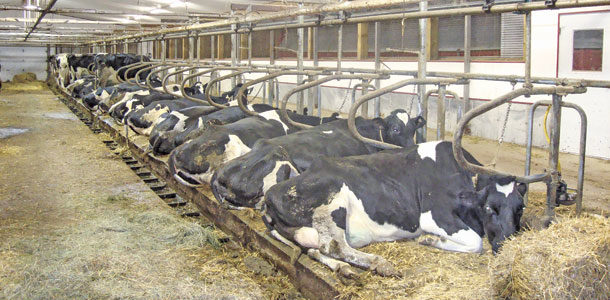Over the years, any time I face a client that is 3X-milking conventionally and is looking to transition to robots, I can feel my stress levels rise. From a pure milk-production perspective, this is one of the most challenging transitions because of the many rapid and simultaneous changes the cows will see as they move to the new system.
It is difficult to keep the cows and the dairy producer’s expectations hitting the targets because of all of the variables. But we have done it and will continue to successfully guide producers milking 3X into robots.
But then there is the most challenging barn: tiestalls.
By far, working on transitions from tiestall barns to robots is, in my opinion, the single most challenging job we do. Looking back, tiestall herds have presented some of the toughest dilemmas and obstacles.
Why are tiestalls so challenging?
Robotic transitions always involve challenges to the cows, the producer and to milk production in startup. But with a tiestall herd, these cows face more challenges in the new robotic environment than a cow coming from a freestall herd.
Tiestall cow troubles
- Laying in alleys. Because tiestall cows aren’t used to freestalls and choosing their own stall, they will often lay in the alleys until they get used to the stalls. These cows will more frequently lay half-in and half-out of stalls.
- Standing. Again, they aren’t sure of the freestall setting, so they will often stand in the stall longer or spend long periods of time standing on the alleys.
- Backing out of a stall. Tiestall cows often aren’t used to having a curb and need time to adjust to a longer loop. Often, they try to go sideways and get caught in the longer loop.
- Decreased dry matter intakes. Tiestall cows often aren’t used to headlocks, so they may struggle to consume TMRs. Variable number two is they are not used to going to feed themselves, so they will often not eat enough meals at the start of the transition.
- Sore feet. With a new barn, new concrete and a lot more walking, the feet of tiestall cows are often not able to stand up to all of the new challenges at once. Coupled with more standing and less dry matter intake, feet issues have been some of the biggest recurring challenges when transitioning tiestall herds.
These are the most common problems when transitioning from tiestalls to robots, and they can be major issues for a dairy producer. Longer standing times and less dry matter intake both factor directly into milk production. Sore feet can cause an even further drop in milk as well as culling issues.
Even cows coming from a freestall barn can have a difficult time with a robot transition, so knowing that tiestall cows are going to face even more than average challenges will hopefully inform your transition planning.
The easy fix: Plan ahead so your cows can train in the facility before you start the robot
A robotic transition often pushes the cow and dairy producer to the edge until after a while they both are used to the new style of milking and management. The ultimate question as a producer with tiestalls is: Do you really want to add all of the new facility stresses on the cow at the same time you’re adding new milking stresses? Your answer should be no.
The best way to ensure that you are not adding undue stress to your cows during startup is to plan ahead. Make your timeline work so you can train your cows to the facility first, before the startup of the robot.
Often in tiestall transitions, producers think that this is impossible to do, but I believe in many cases by planning months in advance, it can work. And I encourage tiestall producers to make every effort to do it because one of the biggest milk losses in tiestall transitions comes from cows not adapting to the freestall barn.
If you’re thinking about building now, then you should have your calendar out to plan the timeline, too. Instead of looking at the barn construction and robot delivery timeline, look at the best cow timeline.
When can the barn get done? How long can I wait before I absolutely must start the robot? Can I figure out a way to delay the robot and milk in the new barn or in a mix of both new and old facilities? What do I need to have? Who do I need to help out?
Planning steps
1. Make a timeline. Work with your builder, robot installer and any financing or other regulatory issue to pencil out the best possible scenario for your cows – not just for you or for the bank or for the builder. Be an advocate for what your cows will need, and they will pay you back.
2. One-month facility transition. Get your cows in the barn preferably one month in advance. They do not have to be out in the new barn 24 hours a day, but if you can get them eight to 12 hours to be in the barn, use the stalls and try eating, that will help.
3. Training. Train them to lie in stalls properly, and teach all of the ones lying in the alley to get up or ship out.
4. Phase in headlocks. Re-establish good dry matter intakes, especially if transitioning to headlocks. Remove some locks and slowly start to incorporate them back in so the cow has an opportunity to eat even if she’s not ready for the lock right away.
5. Build foot health and body muscle. Tiestall cows are not used to walking around often. One of the main things a robot has to have is an active cow. If you can’t get the cows into the new facility, look for other ways to get them walking and building foot health and body muscle.
6. Start the robot.
To ultimately make this work, you’ll have to have careful organization with builders and your robot installer to meet the timeline. The barn must be 100 percent complete before you start the robot so the cows can learn the barn.
For those tiestall producers building new facilities off-site and who cannot train cows to the building in advance, the best advice is to try and accomplish some things in advance at your home site. Then be prepared to put in a lot of extra effort with the animals in the first week to avoid the worst-case scenario. PD
Paul Berdell is a consultant helping dairy producers transition to robotic milking and has more than a decade of experience with robots. His company, Robotic Milking Integration Solutions, works alongside dairy producers around the world. Berdell can be reached by email.
PHOTO
Cows in tiestalls are not conditioned for the added time walking, standing and choosing their own stall. Exposing them to the freestall environment well before starting up the robot can dramatically improve the transition to robotic milking in terms of herd health, producer experience and milk production. Photo courtesy of DCC Waterbeds.







